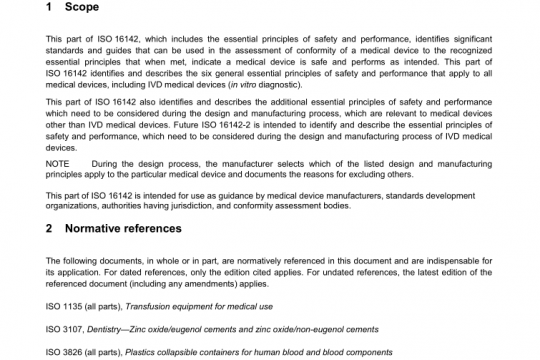AAMI BE78 pdf free download
AAMI BE78 pdf free download.Biological evaluation of medical devices— Part 10: Tests for irritation and delayed-type hypersensitivity.
3.2 blank liquid: Solvent portion treated in the same manner as the identical solvent used for the preparation of test samples but without test material, and which is intended for the determination of a background response of the solvent. 3.3 challenge, elicitation: Process following the induction phase in which the immunological effects of subsequent exposures in an individual to the inducing material are examined. 3.4 corrosion: Slow destruction of the texture or material of a tissue. NOTE—The action of a strong irritant. 3.5 delayed-type hypersensitization: Induction of specific T-cell mediated immunological memory for an allergen to which an individual is exposed, resulting in a delayed-type hypersensitivity reaction after secondary contact with the allergen. 3.6 dose: Quantity to be administered to the test system at one time. 3.7 edema: Swelling due to abnormal infiltration of fluid into the tissues. 3.8 erythema: Reddening of the skin or mucous membrane. 3.9 eschar: Scab or discolored slough of skin. 3.10 induction: Process that leads to the de novo generation of an altered state of immunological reactivity in an individual to a specific material. 3.11 irritant: Agent that produces irritation.3.12 irritation: Localized non-specific inflammatory response to single, repeated, or continuous application of a substance/material. 3.13 necrosis: Death of one or more cells, or portion of tissue or organ, resulting in irreversible damage. 3.14 negative control: Material or substance which, when tested by the procedure described, demonstrates the suitability of the procedure to yield a reproducible, appropriate negative, nonreactive, or background response in the test system. 3.15 positive control: Material or substance which, when tested by the procedure described, demonstrates the suitability of the procedure to yield a reproducible, appropriate positive, or reactive response in the test system. 3.16 solvent: Material or substance used to moisten, dilute, suspend, extract, or dissolve the test substance material. Examples: Chemical, vehicle, medium, etc. 3.17 test material: Material, device, device portion, or component thereof that is sampled for biological or chemical testing. 3.18 test sample: Extract or portion of the test material that is subjected to biological or chemical testing. 3.19 ulceration: Open sore representing loss of superficial tissue.4 General principles—Step-wise approach The available methods for testing irritation and sensitization were developed specifically to detect skin irritation and sensitization potential. Other types of adverse affects are generally not predicted by these tests. This part of ISO 1 0993 requires a step-wise approach, which shall include one or more of the following: a) characterization of test material, involving chemical characterization and analysis of the test sample according to the general principles described in ISO 1 0993-9, ISO 1 0993-1 3, ISO 1 0993-1 4, ISO 1 0993-1 5, and ISO 1 0993-1 8; b) literature review, including an evaluation of chemical and physical properties, and information on the irritation and sensitization potential of any product constituent as well as structurally related chemicals and materials; c) consideration of in vitro tests in preference to in vivo tests, and replacement of the latter as new in vitro methods become available and validated; at the present time, there are no validated in vitro tests (other than simple screens) to detect irritants or sensitizers.AAMI BE78 pdf download.
Other IEC Standards
-

ANSI AAMI ISO 16142-1 pdf free download – non-IVD medical devices and guidance on the selection of standards
AAMI standards list DOWNLOAD -

ANSI AAMI ISO 16142-2 pdf free download – General essential principles and additional specifc essential principles
AAMI standards list DOWNLOAD


